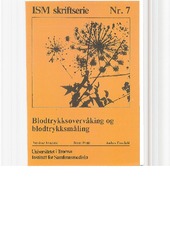| dc.contributor.author | Kristoffersen, Agnete Egilsdatter | |
| dc.contributor.author | Stub, Trine | |
| dc.contributor.author | Musial, Frauke | |
| dc.contributor.author | Fønnebø, Vinjar | |
| dc.contributor.author | Lillenes, Ola | |
| dc.contributor.author | Norheim, Arne Johan | |
| dc.date.accessioned | 2018-04-27T11:32:04Z | |
| dc.date.available | 2018-04-27T11:32:04Z | |
| dc.date.issued | 2018-03-27 | |
| dc.description.abstract | Intentional use of complementary and alternative medicine (CAM) has previously only been researched in small, possibly biased, samples. There seems to be a lack of scientific information regarding healthy individual's attitudes and presumed use of CAM. The aim of this study is to describe prevalence and characteristics of participants who intend to see a CAM provider compared to participants who intend to see a medical doctor (MD) only when suffering from a chronic, non- life-threatening disease and in the need of treatment. Further to describe differences between the groups regarding expected reasons for CAM use and expected skills of CAM providers.
<br>
METHOD:
The survey was conducted in January 2016 as part of the "TNS Gallup Health policy Barometer". In total, 1728 individuals aged 16-92 years participated in the study, constituting an overall response rate of 47%. The survey included questions regarding opinions and attitudes towards health, health services and health politics in Norway.
<br>
RESULTS:
The majority of the participants (90.2%) would see a MD only if they were suffering from a chronic, non- life-threatening disease and were in the need of treatment. Men over the age of 60 with a university education tended to see a MD only. Only 9.8% of all respondents would in addition visit a CAM provider. Being an intentional user of a MD + CAM provider was associated with being a woman under the age of 60. The respondents believed that CAM providers have professional competence based on formal training in CAM. They also believed that individuals seeing a CAM provider have poor health and are driven by the hope of being cured. Further, that they have heard that others have good experience with such treatment.<br>
CONCLUSION:
Intentional use of CAM is associated with positive attitudes, trustworthiness, and presumed positive experiences in the CAM-patient-setting. Intentional CAM users also have the impression that CAM providers have professional competence based on formal training in alternative therapies. | en_US |
| dc.description | Source at <a href=https://doi.org/10.1186/s12906-018-2179-8>https://doi.org/10.1186/s12906-018-2179-8</a>. | en_US |
| dc.identifier.citation | Kristoffersen, A.E., Stub, T., Musial, F., Fønnebø, V., Lillenes, O. & Norheim, A.J. (2018). Prevalence and reasons for intentional use of complementary and alternative medicine as an adjunct to future visits to a medical doctor for chronic disease. BMC Complementary and Alternative Medicine,18(1):109. https://doi.org/10.1186/s12906-018-2179-8 | en_US |
| dc.identifier.cristinID | FRIDAID 1576743 | |
| dc.identifier.doi | 10.1186/s12906-018-2179-8 | |
| dc.identifier.issn | 1472-6882 | |
| dc.identifier.uri | https://hdl.handle.net/10037/12635 | |
| dc.language.iso | eng | en_US |
| dc.publisher | BioMed Central | en_US |
| dc.relation.journal | BMC Complementary and Alternative Medicine | |
| dc.rights.accessRights | openAccess | en_US |
| dc.subject | VDP::Medisinske Fag: 700::Helsefag: 800::Samfunnsmedisin, sosialmedisin: 801 | en_US |
| dc.subject | VDP::Medical disciplines: 700::Health sciences: 800::Community medicine, Social medicine: 801 | en_US |
| dc.subject | Chronic disease | en_US |
| dc.subject | Health care utilization | en_US |
| dc.subject | Complementary medicine | en_US |
| dc.subject | Alternative medicine | en_US |
| dc.subject | Norway | en_US |
| dc.title | Prevalence and reasons for intentional use of complementary and alternative medicine as an adjunct to future visits to a medical doctor for chronic disease | en_US |
| dc.type | Journal article | en_US |
| dc.type | Tidsskriftartikkel | en_US |
| dc.type | Peer reviewed | en_US |


 English
English norsk
norsk


